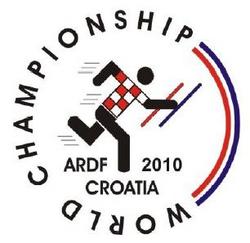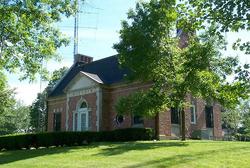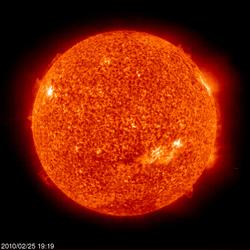
| ARRL Home Page | ARRL Letter Archive | Audio News |
- FCC NEWS : FCC Allows Robotic Device in Amateur Band
- Public Service : Injured Colorado Skier Uses Amateur Radio to Summon Help
- Launch of New ARRL Web Site Delayed to "Get it Right"
- On the Air : ARRL DX Phone Contest Brings DX in Full Force to the HF Bands!
- Section News : ARRL Virginia Section Manager Election Results
- Amateur Radio Direction Finding : Foxes, Fitness and Fun in 2010
- Solar Update
- This Week on the Radio

|
In January 2008, a company called ReconRobotics filed a request with the FCC for a waiver of Part 90 of the Commission's Rules with respect to the Recon Scout -- a remote-controlled, maneuverable surveillance robot designed for use in areas that may be too hazardous for human entry. A waiver is required to permit licensing of the Recon Scout because the device operates in the 430-448 MHz band, which is allocated to the Federal Government Radiolocation service on a primary basis, as well as the Amateur Radio Service and certain non-federal radiolocation systems on a secondary basis. More than two years later, the FCC granted the waiver request in the form of an Order (WP Docket No 08-63), subject to certain conditions.
In its comments filed in May 2008, the ARRL called on the FCC to deny ReconRobotics waiver request, "either permanently or even temporarily." The FCC noted in the waiver that they had received more than 70 comments "generally consist[ing] of public safety and law enforcement entities supporting the waiver request, and amateur radio operators opposing it." In their initial waiver request, ReconRobotics asserted that even thought the device operates in a in an area allocated to other services, including Amateur Radio, the Recon Scout operates with only 1 W peak power and it is "unlikely to cause interference to these services."
The FCC noted in the Order that they had received more than 70 comments "generally consist[ing] of public safety and law enforcement entities supporting the waiver request, and amateur radio operators opposing it." In their initial waiver request, ReconRobotics asserted that even though the device operates in an area allocated to other services, including Amateur Radio, the Recon Scout operates with only 1 W peak power and it is "unlikely to cause interference to these services." Read more here.
|
Steve Priem, N0YIV, shows off his handheld transceiver before a ski trip this past March. [Rick Casey, Photo] |
When Steve Priem, N0YIV, of Boulder, Colorado, decided to go backcountry skiing near Yankee Doodle Lake in the Guinn Mountain area of Colorado's Roosevelt National Forest on Friday, February 19, the 60 year old ham made sure he was well prepared: Not only did he take along a rescue whistle, he made sure his handheld transceiver was fully charged and in his pack.
It's a good thing he did: When Priem was injured while skiing, he used his radio to summon help. According to ARRL Colorado Section Manager Jeff Ryan, K0RM, a ham more than 100 miles away in Colorado Springs answered Priem's call for help and called 911. Priem was able to provide GPS coordinates for his position. Read more here.
|
|
After meeting with ARRL staff on February 23 -- two days before the new ARRL Web site was to launch -- ARRL Chief Operating Officer Harold Kramer, WJ1B, made the decision to delay the unveiling of the Web site until late March. "Work on the new ARRL Web site has progressed at a frantic pace but there are still some potential 'bugs' that could affect members. We need to be sure we get it right," Kramer said. "Our members' security, information and ability to actually use of all the options on the new site outweigh any rush to meet an artificial deadline. It's just good customer service."
The new Web site -- which will contain the online store, class registrations, audio, video, DXCC information, contest data, individualized member options and other 21st century opportunities for members -- is one of the largest technology upgrade activities that ARRL and Fathom, the company programming the site, have ever undertaken. "Reviewers have been unanimously impressed and are helping make sure we create the easiest, most enjoyable online experience possible," Kramer explained.
According to ARRL Media and Public Relations Manager Allen Pitts, W1AGP, the current ARRL Web site is not only used by ARRL members, but is a prime reference source for engineers, hams and wireless technicians around the world, making it the premier place to find information about Amateur Radio, its activities and the sciences behind it. "The Web is our main face to the world, and the new Web site will be fantastic," he said. "Although we all regret the delay, I believe our members will appreciate our diligence about the ease of use, security and navigation for the new site."
 Dave Robbins, K1TTT, of Peru, Massachusetts, works some DX on 15 meters in the ARRL International DX Contest. [Frandy Johnson, N1FJ, Photo] |
With the 2010 ARRL International DX CW Contest now history, the first weekend in March brings the next round of competition: the 2010 ARRL International DX Phone Contest. Like its CW predecessor, this event focuses on DX stations working all US states and Canadian provinces, while US and Canadian amateurs try to work as many DX countries as possible over the 48 hour contest period. Read more here.

|
In the only Section Manager race this winter, Carl Clements, W4CAC, was re-elected as the ARRL Virginia Section Manager. He received 855 votes; his opponent, Glen Sage, W4GHS, received 511 votes. Election ballots were counted February 23 at ARRL Headquarters. Clements, of Portsmouth, starts his new two year term of office on April 1, 2010. In North Carolina, Bill Morine, N2COP, of Wilmington begins his first term as Section Manager on April 1. Section Manager Tim Slay, N4IB, decided not to run again for another term of office, and Morine was the only nominee. Slay has served two terms as North Carolina's Section Manager.
The following incumbent ARRL Section Managers did not face opposition and were declared elected for their next terms of office beginning April 1: Pete Cecere, N2YJZ, Eastern New York; Eric Olena, WB3FPL, Eastern Pennsylvania; Gary Stratton, K5GLS, Louisiana; Bob Schneider, AH6J, Pacific; Steve Early, AD6VI, San Diego, and Scott Rausch, WA0VKC, South Dakota.
By ARRL ARDF Coordinator Joe Moell, K0OV
 Click here to find out more about the 2010 ARDF USA Championships to be held this May in Ohio and the Wold Championships, scheduled for September in Croatia. |
"Geeks in the woods!" That's how Jay Hennigan, WB6RDV, of Goleta, California, describes Amateur Radio Direction Finding (ARDF). Several times a year, Jay gets together with friends for a session of this international Amateur Radio sport -- also called foxtailing and radio-orienteering. As they set out, five 2 meter "foxes" are somewhere in the woods, transmitting for one minute each in sequence. Armed with a special ARDF set or just a handheld transceiver with a measuring-tape Yagi and attenuator, they see how fast they can run or walk from the start to each transmitter in optimum order and then back to the start, or perhaps to a separate finish point. To help them navigate, they carry compasses and special orienteering maps, but they aren't allowed to have GPS displays or other high-tech navigation aids. Standardized ARDF courses provide a good test of equipment performance and hunter skill. It's friendly competition combined with great exercise. It attracts "techies" and "jocks" of all ages who don't need a ham license to get started. And for some, it leads to medals at national and international competitions. Read more here.
|
|
As of Friday, February 19, Iceland's Post and Telecom Administration (PTA) granted temporary experimental access to the 4 and 600 meter bands at least through the end of 2010, according to Islenzkir Radioamatorar (IRA) President Jonas Bjarnason, TF2JB; the ITA is Iceland's IARU Member-Society. After obtaining a special license from the PTA, Bjarnason said that TF stations with "N" or "G" class licenses may now operate between 493-510 kHz and 70.000-70.200 MHz running 100 W. Amateur operations on both bands are granted on a secondary basis.

|
Beginning Monday, March 15, W1AW, the Hiram Percy Maxim Memorial Station, will alternate the digital modes used for its digital bulletin transmissions. While Baudot, PSK31 and MFSK16 still make up the digital mode complement, W1AW Station Manager Joe Carcia, NJ1Q, says that the schedule will be altered to give more exposure to PSK31 and MFSK16. "Because of time constraints and the varying lengths of digital bulletins, there were many instances where only Baudot was used," he said. "With the new schedule, amateurs preferring either PSK31 or MFSK16 will no longer find these modes secondary." Read more here.
 The Sun, as seen on Thursday, February 25, 2010 from NASA's SOHO Extreme Ultraviolet Imaging Telescope. This image was taken at 304 Angstrom; the bright material is at 60,000 to 80,000 Kelvin. |
Tad "Late lies the wintry Sun a-bed" Cook, K7RA, reports: The unbroken string of sunspots continues. Two new groups -- 1050 and 1051 -- appeared in the past two days, and we've now had 36 continuous days with sunspots. Prior to that, there is just a single day once in a while with no spots. The last time we had more than one day of no sunspots was a few months ago, November 23 through December 8. Look for more information on the ARRL Web site on Friday, February 26, including a discussion about an increase in reports of 10 meter activity, and a "reverse beacon network" that uses CW skimmers to automatically check many frequencies from many locations, and then list the calls heard on a Web site. For more information concerning radio propagation, visit the ARRL Technical Information Service Propagation page. This week's "Tad Cookism" brought to you by Robert Louis Stevenson's Winter Time.
|
|
It's that time of year again -- time to start gearing up for ARRL Field Day, June 26-27, 2010! ARRL's flagship operating event -- always held the fourth full weekend in June -- brings together new and experienced hams for 24 hours of operating fun. Field Day packets are now available for download and include the complete rules (including changes for 2010), as well as other reference items such as forms, ARRL Section abbreviation list, entry submission instructions, a Frequently Asked Questions section, guidelines for getting bonus points, instructions for GOTA stations, a kit to publicize your event with the local press and more.

|
The March schedules for the W1AW and West Coast Qualifying Runs were inadvertently left out of the March issue of QST. The March schedules for W1AW are as follows: Friday, March 5 at 10 PM EST (Saturday, March 6 at 0300 UTC) for 10-25 WPM and Tuesday, March 16 at 7 PM EDT (2300 UTC) for 10-40 WPM. The West Coast Qualifying run will be transmitted by station K6KPH on Saturday, March 13 at 2 PM PDT (2200 UTC) for 10-35 WPM. The run will be transmitted simultaneously on 3581.5, 7047.5, 14047.5, 18097.5 and 21067.5 kHz.
This week, look for an NCCC Sprint Ladder on February 26. The Russian PSK WW Contest and the CQ 160 Meter Contest (SSB) are on February 26-27. The REF Contest (SSB), the EPC WW DX Contest, the UBA DX Contest (CW), the Mississippi QSO Party and the North American QSO Party (RTTY) are all on February 27-28. The High Speed Club CW Contest is February 28. The North Carolina QSO Party is February 28-March 1. The ARS Spartan Sprint and the AGCW YL-CW Party are both on March 2. Next week, look for the ARRL International DX Contest (SSB) on March 6-7. The Wake-Up! QRP Sprint is March 6 and the DARC 10 Meter Digital Contest is March 7. The CLARA HF Contest is March 9-10 (continuing on March 13-14) and the CWops Mini-CWT Test is March 10-11. All dates, unless otherwise stated, are UTC. See the ARRL Contest Branch page, the ARRL Contest Update and the WA7BNM Contest Calendar for more info. Looking for a Special Event station? Be sure to check out the ARRL Special Event Station Web page.

|
Registration remains open through Sunday, March 21, 2010, for these online course sessions beginning on Friday, April 2, 2010: Amateur Radio Emergency Communications Level 1; Antenna Modeling; Radio Frequency Interference; Antenna Design and Construction; Ham Radio (Technician) License Course; Propagation; Analog Electronics, and Digital Electronics. To learn more, visit the CEP Course Listing page or contact the Continuing Education Program Coordinator.
